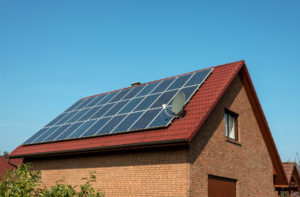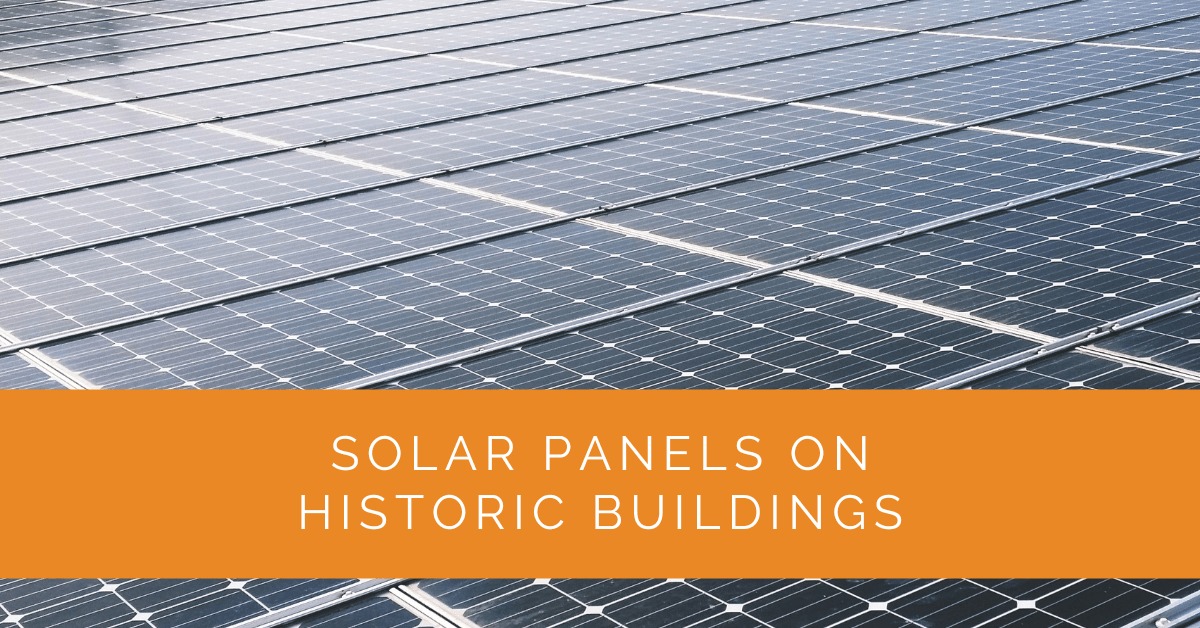Historic buildings are precious remnants of our past, showcasing architectural marvels and cultural heritage. As the world embraces renewable energy solutions, installing solar panels on historic buildings poses a unique challenge. Preserving the integrity of these structures while harnessing solar power requires a delicate balance between history and sustainability.
Contents
- 1 Key Takeaways
- 2 Understanding Historic Preservation and Solar Power
- 3 Assessing Feasibility and Suitability
- 4 Historic Building Solar Feasibility Estimator
- 5 Best Practices for Solar Panel Installation on Historic Buildings
- 6 The Advantages of Solar Energy for Historic Buildings
- 7 Addressing Common Concerns and Misconceptions
- 8 Government Incentives and Support for Historic Solar Installations
- 9 Case Study: Integrating Solar Panels on a Historic Building
- 10 Expert Insights From Our Solar Panel Installers About Solar Panels on Historic Buildings
- 11 Experience Solar Excellence with Us!
- 12 Conclusion
Key Takeaways
- Balancing preservation and solar power is crucial when installing solar panels on historic buildings, requiring collaboration with preservation experts and adherence to guidelines.
- Historic buildings equipped with solar panels can contribute to a greener environment, provide cost savings, and enhance their market value.
- By addressing concerns and myths and utilizing non-invasive mounting techniques, integrating solar panels on historic buildings can showcase a seamless harmony of sustainability and architectural integrity.
Understanding Historic Preservation and Solar Power
What is Historic Preservation?
Historic preservation involves conserving and protecting buildings, objects, and sites that hold historical, cultural, or architectural significance. These structures link to the past, providing communities with a sense of identity and continuity.
The Rise of Solar Power and Renewable Energy
Concurrently, the demand for clean and sustainable energy has led to the rapid rise of solar power. Solar panels harness sunlight and convert it into electricity, reducing reliance on fossil fuels and curbing greenhouse gas emissions.
The Benefits of Solar Panels on Historic Buildings
The integration of solar panels into historic buildings brings several advantages. Firstly, it allows these iconic structures to contribute to a greener environment by generating renewable energy. Secondly, it can significantly reduce energy costs for the building’s occupants, promoting long-term financial savings. Lastly, historic buildings equipped with solar panels can serve as inspiring examples of sustainable practices to the broader community.
Assessing Feasibility and Suitability
Evaluating the Structural Integrity of Historic Buildings
A comprehensive structural assessment must be conducted before installing solar panels on a historic building. Collaborating with preservation experts and engineers is crucial to ensure that the installation process does not compromise the building’s stability or integrity.
Analyzing the Energy Efficiency Potential
Determining the energy efficiency potential of the historic building is vital in designing an effective solar panel system. This analysis considers energy consumption, available sunlight, and the building’s orientation to maximize solar energy generation.
Considering Aesthetics and Visual Impact
Preserving the aesthetic value of historic buildings is paramount. The placement of solar panels should be carefully planned to minimize any visual impact on the building’s façade. By integrating the panels discreetly, the historical significance and charm of the structure remain intact.
Historic Building Solar Feasibility Estimator
Quickly check if your historic property is suitable for solar panels.
This tool provides a general indication. Always consult with local preservation boards and a certified solar installer before planning an installation.

Best Practices for Solar Panel Installation on Historic Buildings
Engaging with Preservation Experts and Authorities
Consulting with preservation experts and local authorities is essential during the planning phase. Their expertise ensures that the solar panel installation adheres to specific guidelines and regulations set forth by the National Park Service or relevant historic districts.
Utilizing Non-Invasive Mounting Techniques
To protect the historic building’s roof, non-invasive mounting techniques, such as ballasted or adhesive-mounted systems, are recommended. These methods eliminate the need for drilling, preventing potential damage to the roofing materials.
Concealing Wiring and Equipment
Wiring and other equipment should be concealed wherever possible to maintain the building’s aesthetic appeal. This careful consideration ensures that the solar panel installation remains discreet and visually harmonious with the historic architecture.
The Advantages of Solar Energy for Historic Buildings
Cost Savings and Return on Investment
Installing solar panels on historic buildings can lead to substantial cost savings. The solar energy generated offsets electricity expenses, providing a long-term return on investment for the building’s owners or occupants.
Reducing Carbon Footprint and Environmental Impact
Embracing solar power helps reduce the building’s carbon footprint, contributing to a cleaner and more sustainable environment. Using renewable energy, historic buildings positively influence the fight against climate change.
Enhancing the Building’s Market Value
Solar panel installations can increase the market value of historic buildings. Prospective buyers and tenants are often attracted to eco-friendly features, making solar-equipped historic properties highly desirable in the real estate market.

Addressing Common Concerns and Misconceptions
Debunking Myths about Solar Panels and Historic Buildings
There are common misconceptions about installing solar panels on historic buildings, such as the notion that it irreversibly alters the building’s appearance. By addressing these myths with accurate information, the benefits and potential for seamless integration become evident.
Preserving the Building’s Architectural Integrity
Preserving a building’s architectural integrity is paramount during solar panel installation. Collaborating with preservation experts and adhering to guidelines ensures that the building’s historical significance and unique characteristics are upheld.
Government Incentives and Support for Historic Solar Installations
Tax Credits and Financial Incentives
Government agencies often provide tax credits and financial incentives for installing solar panels on historic buildings. These incentives help offset installation costs and encourage property owners to adopt renewable energy solutions.
Permitting and Approval Processes
Navigating the permitting and approval processes for solar installations on historic buildings can be complex. Working closely with local councils and authorities streamlines these procedures and ensures compliance with preservation guidelines.
Case Study: Integrating Solar Panels on a Historic Building
Background
At Solar Panels Network USA, we take pride in our ability to merge modern renewable energy solutions with the preservation of historical heritage. This case study highlights our recent project involving the installation of solar panels on a historic building. The project aimed to demonstrate that it’s possible to harness solar power while maintaining the architectural integrity of historic structures.
Project Overview
Our team was tasked with installing a solar energy system on a historic library building. The goal was to reduce the building’s energy costs and carbon footprint without compromising its historical significance and visual appeal. This project required a thoughtful approach to ensure compliance with preservation guidelines while optimizing the building’s energy efficiency.
Implementation
Initial Assessment and Collaboration
We began with a thorough structural assessment of the historic library. Working closely with preservation experts, we ensured that our plans would not damage or alter the building’s original architecture. We also analyzed the building’s energy consumption patterns and solar exposure to design an effective system.
Choosing Non-Invasive Mounting Techniques
To preserve the library’s roof and exterior, we opted for non-invasive mounting techniques. These methods, including ballasted mounts and adhesive-backed panels, allowed us to install the solar system without drilling into the structure. This approach ensured the installation was reversible, a key requirement for historic preservation.
Concealing Wiring and Equipment
Maintaining the building’s aesthetic was a top priority. We meticulously planned the placement of wiring and equipment to keep them out of sight. By routing cables through existing conduits and using discreet enclosures, we minimized the visual impact of the installation.
Results
Enhanced Energy Efficiency
The solar panel system significantly reduced the library’s reliance on grid electricity. The panels generated enough energy to cover a substantial portion of the building’s energy needs, leading to notable cost savings on utility bills.
Preserved Historical Integrity
Thanks to our careful planning and execution, the historic library retained its architectural charm. The non-invasive installation techniques and concealed wiring ensured that the solar panels were barely noticeable, preserving the building’s historical and cultural value.
Community Engagement and Education
This project also served as an educational tool for the community. We organized workshops and tours to showcase the installation, highlighting how renewable energy can be harmoniously integrated into historic buildings. This initiative helped raise awareness about sustainable practices and encouraged local support for renewable energy projects.
Summary
Our project at the historic library demonstrated that it is possible to integrate solar energy solutions into historic buildings without compromising their integrity. By using non-invasive techniques and collaborating closely with preservation experts, we achieved a seamless blend of sustainability and preservation. This case study serves as an example of how renewable energy can be harmoniously incorporated into our cultural heritage, providing environmental and economic benefits while maintaining historical significance.
Expert Insights From Our Solar Panel Installers About Solar Panels on Historic Buildings
Installing solar panels on historic buildings requires a nuanced approach. It’s crucial to balance modern energy solutions with preservation guidelines to protect the integrity of these valuable structures.
Senior Solar Technician
We’ve found that non-invasive mounting techniques are particularly effective for historic buildings. This method ensures that we preserve the building’s architecture while still providing the benefits of solar energy.
Solar Installation Expert
Collaborating with preservation experts is key to successful solar installations on historic buildings. Their insights help us integrate solar panels in a way that respects the building’s history and aesthetic.
Renewable Energy Engineer
Experience Solar Excellence with Us!
Trust in Solar Panels Network USA, where our seasoned experts deliver top-quality solar solutions for homes and businesses nationwide. With a legacy of countless successful installations and a commitment to sustainable energy, we’re your reliable partner in the solar journey. Ready for a brighter, eco-friendly future? Call us now at (855) 427-0058 and harness the power of the sun!
Conclusion
Balancing preservation and solar power installation on historic buildings is a delicate but achievable feat. We can safeguard our historical heritage by embracing sustainable solutions while contributing to a cleaner and greener future. Installing solar panels on historic buildings benefits the environment and showcases the harmonious integration of past and present, setting an example for future generations to follow.
About the Author
Solar Panels Network USA stands at the forefront of solar energy solutions, driven by a team of seasoned solar engineers and energy consultants. With over decades of experience in delivering high-quality solar installations and maintenance, we are committed to promoting sustainable energy through customer-centric, tailored solutions. Our articles reflect this commitment, crafted collaboratively by experts to provide accurate, up-to-date insights into solar technology, ensuring our readers are well-informed and empowered in their solar energy decisions.

